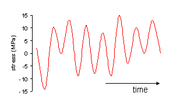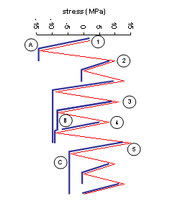
Rainflow-counting algorithm
Encyclopedia

Fatigue (material)
'In materials science, fatigue is the progressive and localized structural damage that occurs when a material is subjected to cyclic loading. The nominal maximum stress values are less than the ultimate tensile stress limit, and may be below the yield stress limit of the material.Fatigue occurs...
data in order to reduce a spectrum of varying stress
Stress (physics)
In continuum mechanics, stress is a measure of the internal forces acting within a deformable body. Quantitatively, it is a measure of the average force per unit area of a surface within the body on which internal forces act. These internal forces are a reaction to external forces applied on the body...
into a set of simple stress reversals. Its importance is that it allows the application of Miner's rule in order to assess the fatigue life of a structure subject to complex loading. The algorithm
Algorithm
In mathematics and computer science, an algorithm is an effective method expressed as a finite list of well-defined instructions for calculating a function. Algorithms are used for calculation, data processing, and automated reasoning...
was developed by Tatsuo Endo
Tatsuo Endo
was a Japanese engineer who, in 1968 along with M. Matsuishi, developed the rainflow-counting algorithm for fatigue analysis of structures while a visiting professor at the University of Illinois.-Bibliography:...
and M. Matsuishi in 1968. Though there are a number of cycle-counting algorithms for such applications, the rainflow method is the most popular as of 2008.
Downing and Socie created one of the more widely referenced and utilized rainflow cycle-counting algorithms in 1982, which was included as one of many cycle-counting algorithms in ASTM E 1049-85. This algorithm is used in Sandia National Laboratories
Sandia National Laboratories
The Sandia National Laboratories, managed and operated by the Sandia Corporation , are two major United States Department of Energy research and development national laboratories....
LIFE2 code for the fatigue analysis of wind turbine components.
Igor Rychlik gave a mathematical definition for the rainflow counting method, thus enabling closed-form computations from the statistical properties of the load signal.
For simple periodic loadings, such as Figure 1, rainflow counting is unnecessary. That sequence clearly has 10 cycles of amplitude
Amplitude
Amplitude is the magnitude of change in the oscillating variable with each oscillation within an oscillating system. For example, sound waves in air are oscillations in atmospheric pressure and their amplitudes are proportional to the change in pressure during one oscillation...
10 MPa
MPA
-Academic degrees:* Master of Professional Accountancy* Master of Public Administration* Master of Public Affairs* Master of Physician's Assistant-Chemicals:* Medroxyprogesterone acetate, also known by the brand name Depo-Provera* Morpholide of pelargonic acid...
and a structure's life can be estimated from a simple application of the relevant S-N curve.
Compare this with Figure 2 which cannot be assessed in terms of simply-described stress reversals.

The algorithm
- Reduce the time history to a sequence of (tensile) peaks and (compressive) troughs.
- Imagine that the time history is a template for a rigid sheet (pagodaPagodaA pagoda is the general term in the English language for a tiered tower with multiple eaves common in Nepal, India, China, Japan, Korea, Vietnam and other parts of Asia. Some pagodas are used as Taoist houses of worship. Most pagodas were built to have a religious function, most commonly Buddhist,...
roof). - Turn the sheet clockwise 90° (earliest time to the top).
- Each tensile peak is imagined as a source of water that "drips" down the pagoda.
- Count the number of half-cycles by looking for terminations in the flow occurring when either:
- It reaches the end of the time history;
- It merges with a flow that started at an earlier tensile peak; or
- It flows opposite a tensile peak of greater magnitude.
- Repeat step 5 for compressive troughs.
- Assign a magnitude to each half-cycle equal to the stress difference between its start and termination.
- Pair up half-cycles of identical magnitude (but opposite sense) to count the number of complete cycles. Typically, there are some residual half-cycles.
Example

- The stress history in Figure 2 is reduced to peaks and troughs in Figure 3.
- Half-cycle (A) starts at tensile peak (1) and terminates opposite a greater tensile stress, peak (2). Its magnitude is 16 MPa.
- Half-cycle (B) starts at tensile peak (4) and terminates where it is interrupted by a flow from an earlier peak, (3), Its magnitude is 17 MPa.
- Half-cycle (C) starts at tensile peak (5) and terminates at the end of the time history.
- Similar half-cycles are calculated for compressive stresses (Figure 4) and the half-cycles are then matched.

| Stress (MPa) | Whole cycles | Half cycles |
| 10 | 2 | 0 |
| 13 | 0 | 1 |
| 16 | 0 | 2 |
| 17 | 0 | 2 |
| 19 | 1 | 0 |
| 20 | 0 | 1 |
| 22 | 0 | 1 |
| 24 | 0 | 1 |
| 27 | 0 | 1 |

